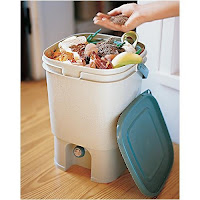In the 1970s, Professor Teruo Higa introduced a compound he named Effective Microorganisms(tm), or EM. Dr. Higa, Professor of horticulture at the University of the Ryukyus in Okinawa, Japan developed the culture from beneficial, naturally occurring microorganisms which can be inoculated into a medium, such as wheat bran, and used to ferment household kitchen refuse. This fermented product is then either buried in the garden or mixed into your normal composting making system, such as compost tumblers, compost bins, or a compost pile, where the decomposition process finishes, thus improving the microbial diversity of the finished compost and the soils and plants in which it is used.
Bokashi is a Japanese term that means "fermented organic matter." It is a byproduct of EM and is used as a compost accelerator. The EM are natural lactic acid bacteria, yeast, and phototrophic bacteria that act as a microbe community within the kitchen scraps, fermenting and accelerating breakdown of the organic matter. Kitchen scraps fermented in this manner will be ready to bury in your garden within two weeks. When you use the bokashi method, your kitchen scraps do not decompose as in traditional composting methods. They ferment, like pickles or wine. Therefore, the finished product does not resemble compost, but, like finished pickles, it looks about the same as when you started, just pickled.
When the fermenting process is finished, the next step is to bury the resulting product in your garden, about a foot deep, or mix it into your regular compost making system and let it finish breaking down into compost.
The liquid that results from the bokashi method is very beneficial to your plants, but should be diluted 100 parts water to 1 part of the bokashi liquid. If you have a septic system, you can pour the liquid down the drain and it will keep your septic system healthy. Other drains in your home that are blocked and sluggish will also be "cleaned out" by the addition of this liquid.
To use the bokashi system in your kitchen for kitchen waste, you will initially need a supply of the bokashi EM mix, which consists of bran, molasses and the microorganisms, and two buckets with tight fitting lids, as the bokashi system is anerobic (without oxygen). You would add a layer of shredded newspapers on the bottom of the bucket with a layer of the bran mixture. Then start adding layers of refuse, about 2 inches thick, each sprinkled with a handful of the bran mixture. Keep the layers compacted so there are no pockets of air. Keep layering until the bucket is full, being careful to keep the air-tight lid on the bucket at all times except when you are adding your kitchen refuse. When the first bucket is full, set it aside and start with the second bucket. The first bucket should continue to process for about two weeks and can then be buried in your garden or put into your regular compost making system. By this time, the second bucket should be full so you can set it aside and start over with the first bucket.
The advantages of the bokashi system are many:
- ALL kitchen refuse can be put into the bokashi system, even fish, meat, cheese, and bones.
- There is no odor as there is no oxygen to react with the scraps and the lid on the bucket is air-tight.
- Since you are not putting the raw kitchen refuse into a compost making system outdoors, you don't have to worry about bugs, or animals digging up the refuse. The finished product that you ultimately put into your garden or compost mixture is already pickled so it doesn't attract bugs or animals.
- The bokashi method is much faster. The resulting product is ready within two weeks of when you finish filling the bucket.
- The liquid resulting from the process is excellent for your plants when mixed with water in a 100:1 ratio.
- You reduce the amount of refuse you put in the local landfills. This not only helps the landfills, but it can save you money.
- As with a wormery, you can use the bokashi mix to ferment dog feces, but you must first mix the feces with other organic matter. Do this separately from the bokashi you will be using for your vegetable garden. After it has fermented, bury it under about 8 inches of soil in your ornamental garden.
- If you have a cat litter box, the addition of a little of the bokashi mixture to the cat litter each week will reduce the odors and is not harmful to the cats. The resulting litter can be processed the same way as dog feces and, after it is fermented, it can be buried in your ornamental garden.
- Your bokashi mixture will last for many years if kept in a dry place out of direct sunlight.
Dr. Higa wrote a book, An Earth Saving Revolution, which explains this process further and how it can help the earth be a better place to live.









